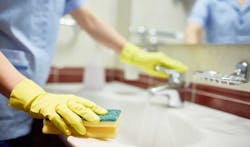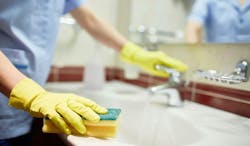5 strategies for creating safer, healthier hotel experiences
From retail-infused brands to Airbnb, the hospitality industry has seen its share of disruptors over the past several decades. These disruptions have been relatively gradual and allowed time for the savvy hotel brands to anticipate and react to change. The COVID-19 pandemic, however, arrived suddenly resulting in the abrupt shutdown of the entire industry. Brands and hotel owners were left scrambling to figure out how to react and strategize their next moves. Some hotels are taking a wait-and-see approach while others are implementing measures so they can open.
The impact of this pandemic is still developing so let’s look at 5 strategies hotels can consider.
1. Wellness and social distancing
Hotels are considering the health guidelines and practices being implemented in other markets—like retail and workplace—with the necessary markers, signage, and graphics to communicate behavior. Directional circulation and elevator queues pose a significant issue for existing hotels. New hotels may want larger circulation/queuing areas but with increased area comes increased costs, so many owners will wait and see what options emerge.
Public areas will see social distancing practices implemented with furniture arrangements. The often-existing communal table in the lobby where hordes of people can work, play, and eat in hotels will be repurposed to allow for a safer flow of guests.
Similarly, expect to see greater spacing of equipment in the hotel gym, especially stations that requires a lot of heavy stationary breathing like ellipticals and treadmills. This equipment area will benefit from screens or strategic placement for the best circulation and air exchange.
Making the cleaning process more visible to hotel guests will help reassure them.
2. Visible sanitization
We can expect that hotel surfaces will be cleaned and wiped much more frequently. Hand-sanitation stations may become more prevalent and staff will wear masks. There is a need to sanitize for health and infection mitigation, of course, but now there’s a psychological incentive to make this process visible to guests to reassure them it is happening.
After the 9/11 terrorist attacks, airlines, and even hotels, implemented new security measures—some were directly impactful, while others had a reassuring effect. I expect the same with this pandemic. It will be important for the guests to feel like they are in a clean environment. Hand-sanitation stations and courtesy cards left by staff in guestrooms stating that no one has entered the guestroom since it was sanitized furthers this notion of elevated infection control and security.
3. Food and beverage adjustments
Changes to food and beverage (F&B) will also have a direct, visible impact on hotel guests. There was a time when having a hotel restaurant was a necessary evil. Fast forward to the beginning of 2020, F&B had become a serious revenue generator for many hotels and the core element of many brand design pillars. The crowded bars, communal tables, and areas for dense social gathering that were a sign of vibrant hospitality are now poised for disruption. The long-term impact on F&B is unknown and will largely depend on consumer confidence levels to patronize these spaces. For now, the shaky future of F&B is having a serious impact to hotel developers’ pro formas.
The “market” concept was already beginning to replace “grab and go” (think Whole Foods replacing 7-Eleven) as the prevalent trend in convenience food and drink at hotels. Post-pandemic, the market model will become much more prevalent, but offering more pre-packaged, self-serve goods rather than unpackaged food behind a glass display.
Following the pandemic, the market model for food options at hotels will become more prevalent.
4. Building materials
Wellness was already a disruptor before the pandemic. But now, it will emerge as a central element as guests look for a safe and clean environment. Some hotel brands were already eliminating carpets in guestrooms for the ease of cleaning and suggestion of cleanliness. That’s because it’s easier to see if a hard surface like tile or luxury vinyl tile is clean versus carpeting. The need for guests to see and “feel” a clean environment drives material type and color for our hotel clients.
In hospitality circles, there’s a discussion over the need to introduce materials that are resistant to carrying viruses. Many designers and operators are taking a wait-and-see approach since introducing the materials limits options and potentially increases cost. At this point, there’s more emphasis on improving sanitization and creating a feeling of wellness and cleanliness than interest in adopting antimicrobial materials.
5. Building systems, technology, and operations
The pandemic has broadened the conversation on how systems, technology, and operations can have a significant impact on new hotels.
Can some parts of guestrooms be cleaned with automation, especially in hard-to-reach areas with UV or other sterilization technologies? Should medical-grade procedures be implemented for laundry services? How should hotels configure air circulation and HVAC equipment? Should they implement the use of negative-pressure floors (another healthcare strategy)? These are just a handful of many questions being asked that will have a significant impact on new construction if they become the norm. The challenge for hotel brands will be if/how aspects of these are implemented in some capacity to existing hotels?
On the customer visible side (“the front of house”), you may see planning that accommodates space for temperature checks upon entry. Some restaurants and other venues are implementing an antimicrobial spray area that one must walk through, but I have a hard time seeing this implemented into the hotel space given a hotel’s emphasis on the guest experience.
Technology is one area that we may see more immediate impacts. At least one major hotel flag was already implementing RFID and smart phone technology for keyless hotel room entry. This has enormous potential. Using your phone to perform as many common actions as possible—from checking in, opening doors, food delivery, calling an elevator, etc.—reduces face-to-face interactions and touch points.
Hand-sanitation stations and courtesy cards left by staff in guestrooms stating that no one has entered since it was sanitized helps elevate comfort.
What the future holds
COVID-19 is the most significant disruptor the hospitality market has seen in recent history—quite possibly, ever. Which strategies for adapting are temporary and which become permanent remains to be seen.
Hotel owners, brands, and designers have a significant challenge on their hands as this pandemic continues to unfold. How do you keep guests safe and make them feel safe without compromising the overall experience? What are the impacts to many of the social pillars related to the lobby and F&B venues that have been trending and factored into hotels’ pro formas? How do you integrate technological advances and new protocols to all guests, not just a select tech savvy group?
The guest experience will undoubtedly change, but it will take some time before we reach a new normal that captures all the positive nuances of travel that brands spent years developing.



